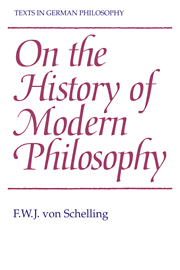Book contents
- Frontmatter
- Contents
- Translator's Preface
- Acknowledgements
- Translator's Introduction
- ON THE HISTORY OF MODERN PHILOSOPHY [Introduction]
- Introduction
- Descartes
- Spinoza, Leibniz, and Wolff
- Kant, Fichte, and the System of Transcendental Idealism
- The Philosophy of Nature (Naturphilosophie)
- Hegel
- Jacobi and Theosophy
- On National Differences in Philosophy
- Index
Introduction
Published online by Cambridge University Press: 05 June 2012
- Frontmatter
- Contents
- Translator's Preface
- Acknowledgements
- Translator's Introduction
- ON THE HISTORY OF MODERN PHILOSOPHY [Introduction]
- Introduction
- Descartes
- Spinoza, Leibniz, and Wolff
- Kant, Fichte, and the System of Transcendental Idealism
- The Philosophy of Nature (Naturphilosophie)
- Hegel
- Jacobi and Theosophy
- On National Differences in Philosophy
- Index
Summary
There are various reasons why, at least as an addition to an introduction to philosophy itself, a look back to earlier systems can also be advisable. Science (Wissenschaft) is also a product of time and constantly develops. Everyone who thinks he is in a position to advance science a big or a small step forward will tend of his own accord to show his relationship to what precedes him, in order thereby to make clear from which point of development or standstill he is taking up science and towards which subsequent goal he intends to advance it. He will stimulate greater interest in his own researches if he shows how, from stage to stage until now, the highest goal has not been achieved. The beginner in philosophy in this way already gets to know, albeit only historically, the issues in question and which of these have primarily concerned the minds of the last centuries. Finally, if it is also necessary, in order to learn to value and judge the truth, to know error, then such a presentation is the best and most gentle way to show the beginner the error which is to be overcome. But the weight of all these reasons increases if it is not just a question of a new method or of changed views in particular matters, but of a change in the concept of philosophy itself.
- Type
- Chapter
- Information
- On the History of Modern Philosophy , pp. 41Publisher: Cambridge University PressPrint publication year: 1994



